News from Ryedale Folk Museum
Read all our press releases and news statements here! For press enquiries, contact: [email protected] or call 01751 417367.
20 May 2024 - X marks the spot! We’re on the hunt for witch marks!
Across the country, old buildings bear the marks of history. But the question is, how many marks and signs are in homes and outbuildings across the North York Moors, some known to their owners and some currently unknown?
Among the star items of Ryedale Folk Museum’s brand new exhibition, ‘Believe it or not?’, exploring magical thinking, are two 17th century ‘witch posts’, both marked with a large X or St Andrew’s cross and thought to keep witches at bay.
“This X design was a well-known protective mark for centuries and the reason that we still cross our fingers for luck,” explains Events Coordinator, Rosie Barrett.
“Our ancestors feared not only witches and their familiars, but also fire and accidents, famine and intruders. To avert a range of threats and dangers, people often engaged in superstitious behaviours, including scratching, carving or even burning protective marks into their homes and outbuildings.”
Another ‘witch post’ can be found in situ at the Museum, in the longhouse Stang End which was moved from Danby during the 1960s. Staff at Ryedale Folk Museum are currently trying to build up a better picture of how prevalent such posts were.
“If a home has one of these very special posts,” explains Rosie, “it’s likely to be next to the fireplace, although we know of examples that have been reused in other parts of a home.”
Another of Ryedale Folk Museum’s buildings contains evidence of magical ways of thinking. “On a doorframe in Harome Hall, our manor house, there are a series of ‘daisy wheels’ or ‘hexafoils’, crated by overlapping circles to form a petal-like design,” explains Rosie. “But other common protective marks that people might find in their homes include the double V sign for ‘Virgo Virginum’, or an M for Mary, both known as ‘Marian’ marks as they refer to the Virgin Mary. Using her sign was another way to shore up one’s home!”
Finally, mesh-like shapes or hash lines might be found, believed to have formed a ‘trap’ for any evil forces that may enter the home.
If you have information about witch posts or protective marks in your own property, Ryedale Folk Museum would love to hear from you. Please email [email protected]
You can visit Ryedale Folk Museum’s exhibition, ‘Believe it or not?’, until Sunday 17 November, daily except Fridays.
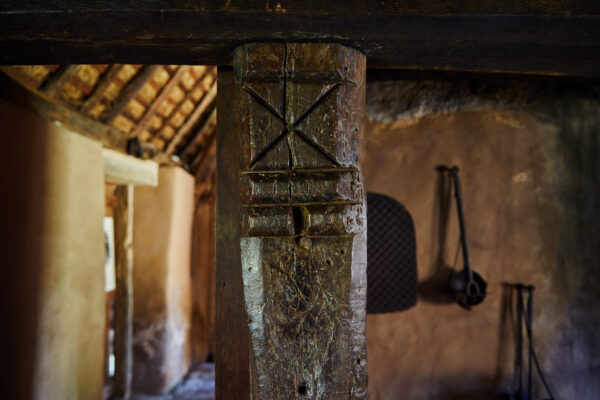
20 March 2024 - Enchanting new exhibition explores magical thinking
Until 17 November 2024
A new exhibition featuring over 200 objects exploring folk beliefs and ‘magical thinking’ has opened at Ryedale Folk Museum in the North York Moors National Park. ‘Believe it or not?’ explores the traditions and rituals of our ancestors, and whether we are still ‘magical thinkers’ today.
Featuring heavily within the exhibition are the stories of those accused of witchcraft, explored through their own objects. These include a crystal ball that was passed down by those seeking to foretell the future, and four sigils or ‘spell tokens’, likely created as a form of ‘love magic’ by a magical practitioner or service magician.
“We have such a rich heritage in this region,” explains Ryedale Folk Museum’s Director, Jennifer Smith. “This exhibition is a significant opportunity for us to share objects that explore how people thought in the past, which can sometimes be quite nebulous. These objects offer real, tangible examples of how people put their beliefs into practice.”
It’s quite rare for museum collections to include the type of folk objects that were created and owned by those accused of witchcraft.
“We have brought together a very special selection of rare objects, from our own collection as well as items kindly loaned to us,” says Jennifer. “Often such objects were not collected because they weren’t considered valuable within their time, or else they were feared and shunned because of their magical associations.”
Staff have been working with Brian Hoggard, author of ‘Magical House Protection: The Archaeology of Counter-Witchcraft’, to explore a range of objects with supposed magical and protective properties.
Brian says: “I think within this exhibition visitors will find such a lot of unusual beliefs and practices to wonder at. The fear people had of the supernatural was, by today’s standards, all pervasive. There were protective or ‘apotropaic’ marks for keeping evil at bay, old shoes for use as decoys, and herbal charms and written incantations for almost anything else.”
Other items on display include: a collection of medicinal charms accumulated by Victorian naturalist and folklorist William Clarke and part of the collection of Scarborough Museums and Galleries; customs surrounding ‘witch bottles’, with items on loan from York Castle Museum; and a range of folk objects embellished with protective markings from Ryedale Folk Museum’s collection. Themes include magical associations of folk dance, including Morris dancing and sword-dancing customs, and ritualistic traditions of the harvest through the museum’s substantial collection of artistic corn dollies.
‘Believe it or not?’ can be seen at Ryedale Folk Museum until Sunday 17 November.
The museum is open every day except Friday, from 10am. Entry to the exhibition is included within the price of a standard museum entry ticket and tickets last for a year from date of purchase.
A book accompanying the exhibition available to buy from the museum’s shop and a programme of complementary events, talks and family activities is available via the website: www.ryedalefolkmuseum.co.uk
Media Contact: Rosie Barrett, Events and Marketing Coordinator, [email protected]
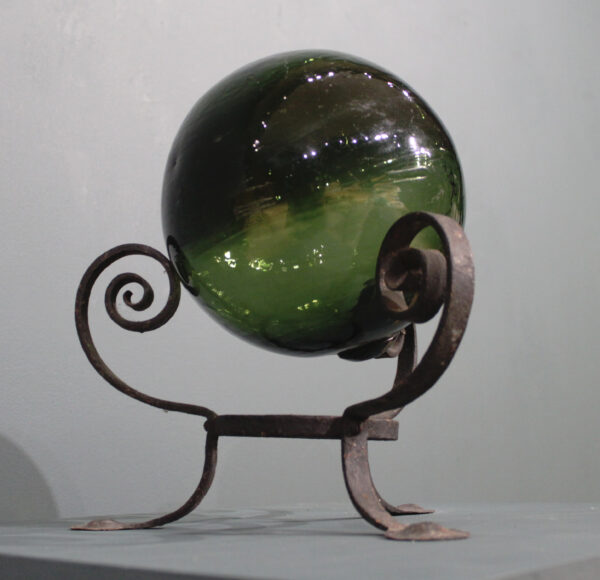
15 November 2023 - Support Ryedale Folk Museum in its 60th year
Ryedale Folk Museum has unveiled a new initiative inviting individuals to ‘adopt’ objects from its diverse collection, all part of the Museum’s 60th anniversary celebrations. The initiative aims to support the conservation of historic buildings and a variety of objects in this important year in the Museum’s history. Set in six acres of the North York Moors National Park, the open-air museum is dedicated to telling the story of the people of the region.
Museum Director Jennifer Smith says, “We’re delighted to launch this initiative as we prepare to celebrate the 60th anniversary of Ryedale Folk Museum next season. We know the Museum is such a special place for so many people – for those who have volunteered with unwavering commitment throughout the last six decades, the great many people who have generously donated the objects that we care for, and our loyal visitors, of course.”
Ryedale Folk Museum is home to some 40,000 objects, many beautifully displayed across more than 20 heritage buildings in Hutton-le-Hole. Staff hope that by inviting members of the community to ‘adopt’ one of the objects in the Museum’s care, a wider range of individuals can also become a part of the story.
“We’re absolutely committed to preserving this heritage for generations to come,” explains Jennifer. “That means for the next 60 years and for the years beyond. We have brought together this selection of 60 objects as an important fundraiser for the Museum this year. As I’m sure we can all appreciate, there’s a great deal of work to be done to care for this special and unique heritage.”
The ‘Adopt an Object’ campaign offers supporters the opportunity to select an artefact that aligns with their interests and passions. “We have so much variety within the collection,” says Jennifer. “We’re sure there will be something to appeal to everyone, with objects starting from £25.”
The objects range from the beautiful to the quirky, with some sharing important local stories, as well as a number of rarer items. There’s a pair of delicate Georgian shoes, a ‘sweetheart cushion’ made during the First World War, and even a rather dubiously named Victorian ‘skirt lifter’ – which was designed to protect long dresses from anything unpalatable underfoot.
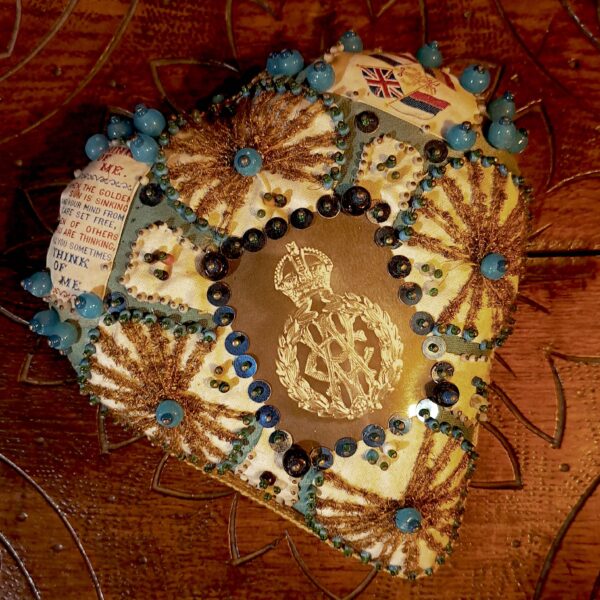
Visitors to the Museum’s website will find beekeeping equipment, a dental treadle, and even a collection of rare eighteenth-century love-spell tokens. “We expect some of them may find their way into people’s lives as Christmas presents too!” says Jennifer.
“For the larger budgets, we have also selected some of our very special buildings for adoption,” adds Jennifer, “including a range of workshops representing important rural trades, an atmospheric Iron Age Roundhouse and the historic Stang End cottage, our first domestic building which was relocated from the village of Danby during the 1960s and includes a very rare ‘witch post’ in situ.”
Contributions will directly support the maintenance and preservation of the Museum’s historic buildings and objects. “By helping us to commemorate Ryedale Folk Museum’s 60th anniversary in this way, supporters can be assured that they’re also helping to secure the legacy of North York Moors’ history and heritage,” says Jennifer.
Objects can be selected via the Museum’s website and can be ‘adopted’ on a first-come, first-served basis. Visit www.ryedalefolkmuseum.co.uk to find out more.
15 July 2023 - New Exhibition: Pub! in the Art Gallery
A new exhibition at Ryedale Folk Museum shares pubs from across the North York Moors and Ryedale. The museum has launched the exhibition, ‘Pub!’, on display in the Art Gallery until Monday 4 September, to showcase historic photos from the collection.
The pub is rooted in the identity of Britain’s culture – and the North York Moors and Ryedale have many brilliant and well-loved pubs and inns. Now, visitors to the exhibition can see historic photos capturing examples from the region.
“We’ve delved in to the archives to share photos of pubs, past and present,’ says Museum Director, Jennifer Smith. “Our Yorkshire pubs are such an important part of rural life and we wanted to try and capture something of what that means to people.”
Visitors will find photos of pubs they may know and recognise, such as the sixteenth-century The Lion Inn, located at the highest point of the North York Moors National Park at Blakey Ridge, and others no longer trading, like Saltersgate Inn which was demolished in 2018 and famous for its smuggling stories.
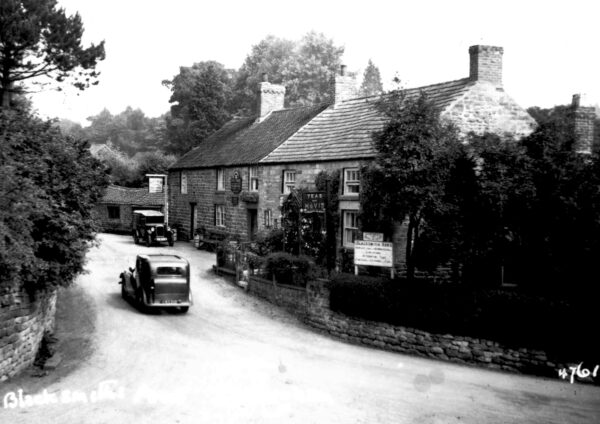
Contributions from three local publicans are also feature in the exhibition, including Jake Leonard, landlord of The Crown Inn in Hutton-le-Hole and Andrew Pern, landlord of The Star Inn at Harome.
“It was wonderful to talk with our local publicans about the exhibition and share their role within the local community,” says Jennifer. “Jake gave us his tips for serving the perfect pint and Andrew shared the heartwarming support he received from his village following the devastating fire at The Star Inn at Harome.”
Additionally, the exhibition also features artworks on sale on the theme of the pub, by Tim Gomersall, Stephen Boxall, Lesley Wood, Colin Culley, Leila Roberts and Martyn Hayes. “We’re delighted to be able to include these contemporary artistic interpretations of the theme too,” says Jennifer.
The exhibition is hosted in the picturesque location of Ryedale Folk Museum, in the North York Moors village of Hutton-le-Hole, and right next door to one of the featured pubs. The open-air museum tells the story of the people of the North York Moors through 20 heritage buildings and more than 40,000 objects.
The exhibition can be seen for free, from Wednesday 19 July until Monday 4 September, in the Art Gallery at Ryedale Folk Museum.
For more information visit www.ryedalefolkmuseum.co.uk
31 May 2023 - From Rags to Rugs - new exhibition at Ryedale Folk Museum
A new exhibition has launched at Ryedale Folk Museum exploring the art of celebrated rag rug artists Lewis and Louisa Creed. Between them, the married couple created over 400 original and creative artworks using recycled materials. Now, a dozen are on display at the Museum until Sunday 9 July.
It began 35 years ago when Louisa first saw a traditional rag rug in a museum. Rag rugs have been created within the homes of the everyday people of Great Britain for centuries. Embellishing a piece of textile with loops made from recycled fabric was a very practical response to poverty and need. But, by the 1980s, it was in decline. Fearing that she had encountered a dying artform, Louisa decided to have a go herself.
“We’re absolutely delighted to be able to share these beautiful artworks from our collection,” says Events Coordinator, Rosie Barrett. “Lewis and Louisa’s rugs show us the artistic potential to be found within simple recycled materials. At a time when so many people are looking for creative ways to reuse and recycle, it’s wonderful to be able to showcase the couple’s wall hangings – and hopefully inspire visitors too!”
Louisa uses a hooky rug technique where long strips of fabric are pulled through hessian with a hook. Her husband Lewis also took up the craft after almost a decade spent observing his wife at work. Lewis passed away in 2021, but his legacy remains and Louisa, now in her 80s, is still crafting.
“Traditionally, the hessian bases needed for rag rugs were often taken from old food sacking, reminding us of moments in history when nothing was wasted,” says Rosie. “Though Louisa has always purchased new hessian, her rags continue to use recycled materials.
“Becoming known sometimes as ‘thrift rugs’, rag rugs originally offered a resourceful way to create warmth and thickness out of old scraps. It is not surprising that they gained renewed interest in the ‘Make Do and Mend’ years of the Second World War.”
However, the dozen rag rugs currently on display at Ryedale Folk Museum showcase a very different approach to this time-honoured craft.
“Mine are always wall hangings,” explains Louisa, “Not for floors. I see them as paintings in fabric. Nowadays, I often tend to start with a just doodle and then I see how they develop.”
“By choosing rags in close-toned shades,” adds Rosie, “Louisa is able to bring life and depth to the scenes depicted. ‘From Rags to Rugs’ reminds us that rag rugs can be wonderful works of art, offering almost endless design possibilities.”
‘From Rags to Rugs’ is on display in the art gallery at Ryedale Folk Museum until Sunday 9 July.
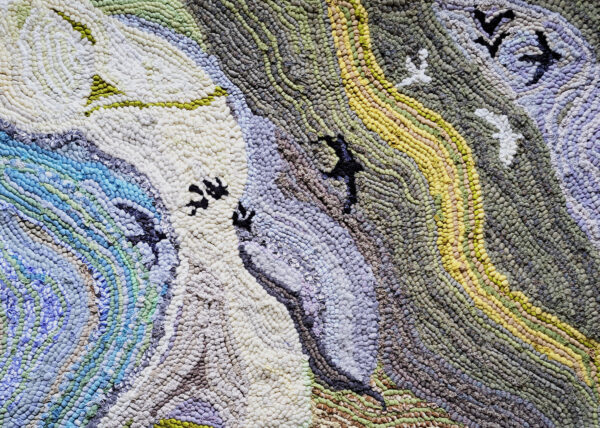
1 May 2023 - Join us for a Volunteer Recruitment Day
Ryedale Folk Museum is holding an open day to recruit new volunteers on Wednesday 10 May.
Set in over six acres of land in the moorland village of Hutton-le-Hole, the Museum tells the story of the people of the region. Staff are currently seeking new volunteers for a range of roles.
“We are particularly interested in hearing from people who would like costumed roles around some of our 20 heritage buildings,” explains Operations Manager, Hannah Highsted. “The roles really help us to bring the site alive!”
The open day is being held between 10.30am and 3.30pm on Wednesday 10 May. Those interested are encouraged to visit Ryedale Folk Museum between those times to meet the team and some of the volunteers and find out more about the Museum and the volunteer opportunities. There’s no need to book – anyone interested can drop in as convenient throughout the day.
“We really rely on people who are passionate about preserving and sharing Ryedale’s heritage,” says Hannah. “We think it’s a fantastic museum and such a unique space to work in! There are lots of ways for people to help. It might be by being a shop keeper in our 1950’s village store, a Victorian school teacher or baker, or even sharing a passion for a particular craft through demonstrations.”
“As well as being so vital to us, our volunteers tell us that it’s also incredibly rewarding from their perspective too! Costumed interpretation isn’t everyone’s cup of tea though, so we’re encouraging people with a range of interests to come and meet us!” adds Hannah.
The museum re-opened for the season in March and launched a brand new community-focused wedding dress exhibition at Easter. Ryedale Folk Museum is a registered charity.
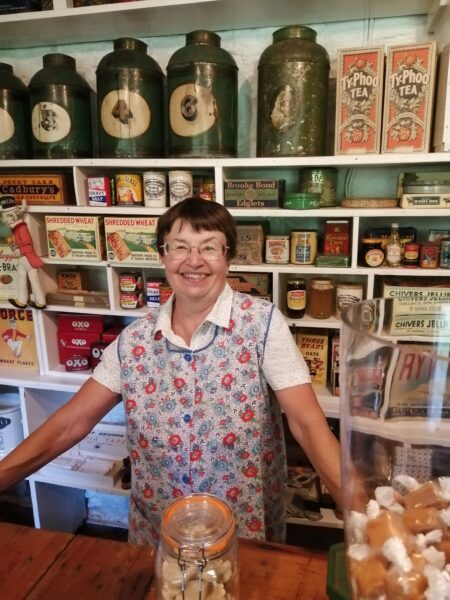
4 April 2023: New Wedding Exhibition - 'Something Old, Something New' launches on Easter Saturday
A dazzling new exhibition of wedding apparel from Ryedale and the North York Moors opens at Ryedale Folk Museum on Easter Saturday.
‘Something Old, Something New’ brings to life the stories of weddings in the region as told through the people who live here and the outfits they wore. As well as delving into the Museum’s own costume collection, the exhibition features dresses on loan from members of the community
Museum Director Jennifer Smith says: “It’s been wonderful to have the opportunity to meet with so many couples and share their stories. The exhibition features dozens of bridal gowns and lots of photos as we’ve tried to show the breadth and variety of weddings in the region.”
The exhibition has been planned and developed with support from across Ryedale and the North York Moors. “We always say that we share the stories of the people of the region – this time,” says Jennifer, “we’ve been able to work directly with our community to do this, taking a strongly collaborative approach that has been really important to us.
“We think visitors will be surprised by the variety on display and enjoy the changes in fashions and glimpses into the personalities and priorities of the couples featured,” explains Jennifer. “Each dress has its own story to tell.”
With wedding-day attire from a range of historical periods, the exhibition includes wartime bridal gowns that would have been created by saving ration coupons. “It would have meant going without other clothes throughout the year,” says Jennifer. “There are also some fun outfits from the 1960s and 70s, including a shorter wedding dress from 1963, when hemlines were starting to rise, and a crocheted outfit featuring a hood, inspired by the film Doctor Zhivago.”
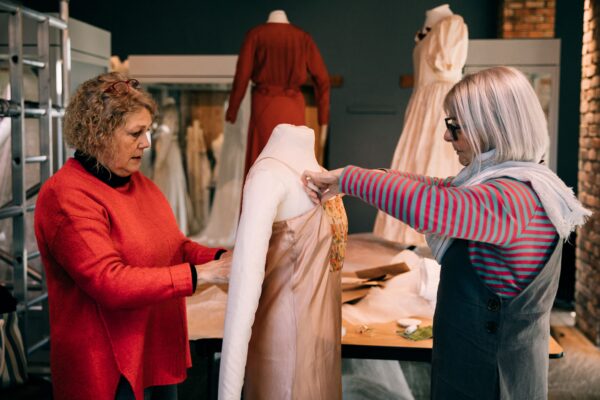
Our dedicated volunteers during exhibition installation
At the other end of the spectrum is a Victorian gown, from the Museum’s own collection. “It was worn in the 1880s by a Ryedale lady named Ena Johnson,” says Jennifer. “Although the majority of dresses featured are white, Ena’s is a beautiful purple taffeta, built up at the back with a bustle – the section of undergarment that supported the ruffled rear. It wouldn’t have been comfortable, but it was clearly well-made. We’ve chosen to display the bustle separately so that visitors can get a better idea of how it worked.”
As well as showcasing bridal gowns, the exhibition is rich with behind-the-scenes stories too: “There are some brilliant near-misses, weddings that almost didn’t happen, and even a bridegroom whisked away under clandestine circumstances for the D-Day landings!” explains Jennifer.
The exhibition will run all season, from Saturday 8 April until Sunday 12 November and the Museum is grateful for support from the North York Moors National Park Authority’s Local Businesses Tourism Contribution fund.
Visitors will also be able to explore the museum’s beautiful grounds and buildings while there. Ryedale Folk Museum is a popular destination for tourists and locals, nestled in the moorland village of Hutton-le-Hole.
For more information about the exhibition and Ryedale Folk Museum, please visit the website: www.ryedalefolkmuseum.co.uk/whats-on-2/
ENDS
For press enquiries, contact: [email protected] or call 01751 417367
15 March 2023 - New Exhibition 'The Handworkers' celebrates traditional crafts
A new exhibition at Ryedale Folk Museum is set to explore the beauty and diversity of a range of traditional crafts.
Opening on Monday 20 March, ‘The Handworkers’ is the creation of award-winning documentary photographer Rachel Rimell. The exhibition showcases the work of skilled artisans who specialise in handwork techniques, putting the focus on a range of traditional and heritage skills that play a part in the rural economy in the twenty-first century.
The exhibition will feature a range of traditional crafts, from basket weaving and blacksmithing to pottery and textiles, focusing on individuals still working with traditional methods. Thatching, a craft that has been practiced for centuries, will also be represented. Visitors will have the chance to see up close the intricate work involved in creating a range of handcrafted products.
The exhibition shows the skill, care and attention to detail that these hand-working techniques embody, that modern mechanised processes can’t always reproduce.
“I wanted to shine a light on these crafts and skills that rely on deep knowledge and understanding of traditions,” explains Rachel. “as well as a pride in workmanship. In many cases, they’re united in the fact that they reach back centuries, often relying on the land and natural materials. Many people just don’t realise that these skills are still a vital part of the rural economy.”
Rachel is a multi-award-winning visual and photographic artist, now based in North Yorkshire. A photographer and photo-journalist by training with over 25 years’ experience, Rachel has photographed all walks of life from the Royal Family to sheep farmers.
“We’re delighted to host this beautiful exhibition at Ryedale Folk Museum,” says Events Coordinator Rosie Barrett. “At the museum, we share the stories of the ordinary people of the region, and this often includes sharing the jobs that they have done over the centuries. We view these stories from the present-day, documented by Rachel, as an important part of the history and heritage of the region. It’s wonderful to see such highly-skilled craft forms and industries alive in the region, and the thriving creativity and skill.”
The series was made possible with support from Ryedale District Council and is a celebration of region’s creativity. At a time where mechanised processes have often superseded the heritage skills of generations, it is also a celebration of traditional workmanship.
‘The Handworkers’ will take place in the art gallery at Ryedale Folk Museum from Monday 20 March until Sunday 30 April. Entry to this part of the museum is FREE.
See Ryedale Folk Museum’s website for further details: www.ryedalefolkmuseum.co.uk/whats-on-2/
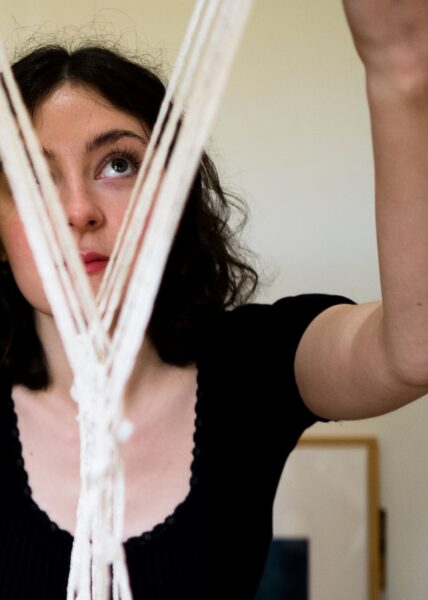
14 November 2022 - Ryedale Folk Museum seeks your wedding stories
An exciting community-focused exhibition will launch next Easter at Ryedale Folk Museum and staff at the museum are currently asking for contributions from locals.
“We want to tell the stories of weddings in Ryedale and the North York Moors – the places and, most importantly, the people,” explains Museum Director, Jennifer Smith. “We’d love the exhibition to truly reflect the lives of those who live here. We’re hoping to hear from people who married here and want to share memories from their special day.”
There are lots of ways for people to contribute to the exhibition and locals have until 20 January to send their stories via the website.
“We’ll be doing our very best to share as many wedding day photos from the community as we can,” says Jennifer, “and we’re also hoping to hear from anyone interested in lending wedding attire for the duration of the exhibition, including wedding dresses, grooms’ outfits and bridesmaid gowns.”
The Museum has a fascinating costume collection and staff intend to share wedding outfits previously donated too.
“Over the years, we’ve found that people have been keen to share items associated with their weddings, a reflection on the significance of the day in our lives,” explains Jennifer. “We already have some brilliant stories. One very pale green dress in the collection was hand-embroidered with an Art-Nouveau style design, most likely by the bride herself.
“Annie Newton had become a housemaid in Glaisdale on the North York Moors when she fourteen, so would have been skilled in needlework. She married in 1919, aged thirty, and the dress was donated to the Museum after her death in 1972 – but not before it had survived life as the lining for a dog bed and a ‘kill or cure’ clean in a washing machine! It’s in amazing condition, all things considered,” adds Jennifer.
The exhibition will be on display for seven months during the 2023 season and the Museum is grateful for support from the North York Moors National Park Authority’s Local Businesses Tourism Contribution fund. It will be the first of a new programme of temporary exhibitions telling the stories of Ryedale and the North York Moors.
“We’d really love the stories we share to speak of the real residents – and the things that matter here, right up to the present day,” says Jennifer. “There are no time restrictions for when the weddings took place – it’s about gathering the experiences of the people of the region, whether it’s an interesting story about someone’s grandparents’ big day, sharing a mother’s saved wedding dress, or if people want to tell us about their own wedding last week!”
The Museum has been collecting and sharing the stories of the region since the 1960s. The collection now spans numerous themes including rural life, agriculture and farming, local industries, and folklore.
“There are also lots of folk traditions associated with weddings in the region,” says Jennifer. “For example, traditionally, upon arriving home after her wedding, a Ryedale bride would be given a small ‘Bride Cake’. She’d eat a little then throw the remainder over her head to ensure that she and her new husband would always have enough and something to spare.
“We’d love to hear about any special traditions kept by couples today, perhaps even unique to particular families,” continues Jennifer. “We’re also interested in the quirky and unusual stories too – weddings or receptions in surprising places, wedding mishaps and happy endings, all the tales from the day that make our weddings so personal.”
The museum is no stranger to weddings. During lockdown, Ryedale Folk Museum successfully applied for funding to become a wedding venue, with nine licensed buildings available for couples to get married in. “So far, we’ve hosted twenty weddings at the museum and it was really that experience that led us towards the theme for this exhibition. We’ve had the privilege of sharing in couple’s very special days and seeing what their wedding days mean to them!”
Stories and photos can be shared via the Museum’s website. Staff will be in touch with some contributors to find out more information.
Full details can be found: www.ryedalefolkmuseum.co.uk/get-involved/

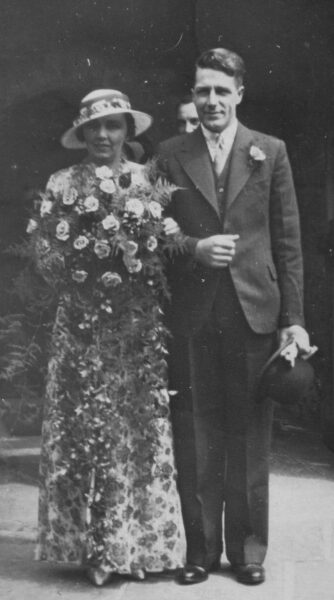
Mary Skilbeck and Sydney Wilson
13 September 22 - Together and Apart – new exhibition launches at Ryedale Folk Museum
An exhibition of new works by the renowned North York Moors painter Peter Hicks and his long-time friend and ceramicist Peter Hough, from Scarborough, opens on Saturday 17 September at Ryedale Folk Museum.
The two friends met aged just eighteen at Scarborough Art College in the 1950s. “We started at the same time in a small circle of friends – it was a very happy time,” explains Hough. For decades they pursued their own artistic paths, both continuing to create and develop as artists. But years later, a chance reacquaintance offered the opportunity to resume their friendship.
Now, ‘Together and Apart’ brings together Peter Hicks’ paintings and Peter Hough’s ceramics as they continue to evolve with the pair now in their eighties.
“It’s a fascinating exhibition,” explains Museum Director, Jennifer Smith. “Their artwork clearly reflects their own unique styles – Peter Hicks’ evocative and abstracted landscapes responding to the region of the National Park, and Peter Hough’s beautiful ceramics often showing the resonant influence of the sea through the shapes, textures and colour palettes. And yet, visitors will also be able to see the way the men have responded to each other. It’s been very exciting to see the ways their artwork seems to fit together.”
Across the exhibition, you can also read their thoughts about the impact of those early years and the way their art has responded to time and friendship.
The friends clearly value each other’s opinions. “Showing work with a friend is a lovely experience – showing alongside people you care about,” explains Hicks. “I’m always so impressed by Peter’s work. His fossil forms echo what he sees within his coastal experience, intriguing because, like so much of Peter’s work, they imitate nature with such apparent ease.”
The exhibition is also a nice opportunity to purchase art at affordable prices. As well as larger pieces, there are a number of smaller-scale works, with original ceramics starting at £16 and original paintings from £85.
The exhibition runs from Saturday 17 September until Sunday 13 November.
There is no charge to visit this exhibition in the art gallery. It is not in the paid area of the Museum.
Visit the website for more information What’s On – Ryedale Folk Museum
Open Saturday to Thursday, 10am – 5pm in September and 10am – 4pm in October and November. Closed on Fridays.
8 August 22 - Ryedale Folk Museum unveils new film to share Cornflower Conservation
Ryedale Folk Museum unveils new film to share Cornflower Conservation
Ryedale Folk Museum has unveiled a new short film dedicated to sharing the Cornfield Flowers Project over two decades on. Developed with funding from the Culture Recovery Fund, administered by Arts Council England to support organisations in the wake of the pandemic, the film provides opportunities for people to engage with the site digitally, as well as throughout the year.
“Our cornfield was established in 1999 as part of a project to track down increasingly rare arable plants, many at imminent risk of extinction,” explains Events Coordinator Rosie Barrett. “It began with the concerns of local naturalist Nan Sykes in the late 1980s – she conducted her own survey of the North York Moors National Park and was deeply unsettled by the number of plants that she couldn’t find.”
By 1998, there were enough individuals and organisations who shared Nan’s concerns to launch the Cornfield Flowers Project in the region. A target list of plants to nurture and grow was drawn up, based on species that were known to have been in the North York Moors National Park at the start of the twentieth century.
“For most of the agricultural year, our field is tucked away, walked past on a trip to the reconstruction Iron Age Roundhouse, but each August it makes its presence felt in wonderful blooms of colour,” says Rosie. “It’s all thanks to those intial steps taken in the 1990s, but our staff and volunteers continue to work throughout the year to ensure this legacy, sowing and harvesting a crop.
“We run events on site to share the cornfield with visitors too, and now the video is a lovely opportunity to reach a wider audience with this important story. The video features Chris Toohie from Wold Ecology LTD, which has provided ongoing financial support to the Museum in recent years.”
Early in the project, seeds were collected and deposited with Kew Garden’s Millennium Seed Bank and the field was shared with local farmers, many of whom were also aware that changes to farming methods had led to the loss of this arable plant heritage. Today, the demonstration cornfield at the Museum remains one of the only sites in the north of England in which to view some of the rare arable wildflower species.
“These plants would have been commonly seen by our ancestors,” explains Rosie, “but today most of us are unlikely to encounter them in the wild. The critically-endangered shepherd’s needle is rarely seen outside the south-east, particularly Suffolk, and the large-flowered hemp nettle’s last remaining stronghold in this country is in the Midlands.”
Following the Second World War, the steps taken to increase crop yields were devastating for these wildflowers, viewed as ‘weeds’. Many of the chemicals that protect crops made survival impossible for the plants that thrived in agricultural fields.
“These are beautiful and exceptionally rare flowers,” says Rosie, “but they are also important plants for pollinators, part of a wider ecosystem, and our cornfield is buzzing at this time of year.”
Ryedale Folk Museum has also commissioned artwork from York-based artist Kate Semple and visitors are able to purchase merchandise featuring the new design from the museum shop. All proceeds from the sales go to support with conserving the cornfield.
More information about the Cornfield Flowers Project can be accessed here, including the new short film:
www.ryedalefolkmuseum.co.uk/conserving-cornflowers-at-the-museum/
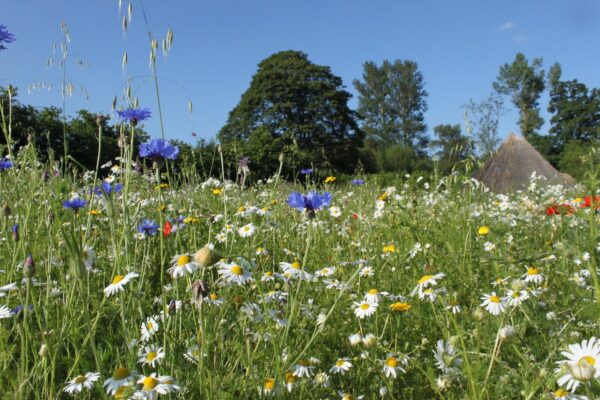
Acknowledgements
The project has been supported by Arts Council England, the national development agency for creativity and culture.
A note from Arts Council England: We have set out our strategic vision in Let’s Create that by 2030 we want England to be a country in which the creativity of each of us is valued and given the chance to flourish and where everyone of us has access to a remarkable range of high quality cultural experiences. We invest public money from Government and The National Lottery to help support the sector and to deliver this vision.
Following the Covid-19 crisis, the Arts Council developed a £160 million Emergency Response Package, with nearly 90% coming from the National Lottery, for organisations and individuals needing support. We are also one of the bodies administering the Government’s unprecedented £1.57 billion Culture Recovery Funds. Find out more at www.artscouncil.org.uk/covid19
Media Contact:
Rosie Barrett, Events and Marketing Coordinator : [email protected]
14 July 2022 - Why Summer Shows are the Perfect Places to Discover Yorkshire Dialect
Dialect and Heritage Engagement Officer Claire Midgley, based at Ryedale Folk Museum, will be taking the Great Big Dialect Hunt to some of our favourite Yorkshire shows this summer, including Borrowdale, Danby and Ryedale.
It’s all part of the new research being conducted by the University of Leeds to find out how we speak. In the 1950s and ’60s, researchers from the university carried out the Survey of English Dialects, visiting people in more than 300 places in order to record their many ways of speaking.
“More than half a century later, we want to find out what has changed and what has stayed the same with this new survey. I’m really looking forward to attending the country shows,” says Claire. “The Survey of English Dialects included questions relating to farming dialect, including a section on working horses and their equipment.
“The fieldworkers who visited the North York Moors recorded many interesting words, such as haltershank for tething rope, barfan, meaning horse collar, and Galloway, the local name for a pony or small breed of horse. And there are many items of agricultural interest in the collection at Ryedale Folk Museum as well as fascinating historic photos in the archives that give an insight into everyday life among farming communities.”
In 1951, one dialect informant, Harold Ross, told fieldworkers visiting Skelton that the local name for a pony and trap was a galloway-and-pig. “Across most of the moors,” says Claire, “you wouldn’t harness a horse, but gear it up. And here they wear blinders to protect their eyes, not blinkers.”
“We’re already running some reminiscence sessions in Borrowby, Danby and across Ryedale, so the shows are another great opportunity for people to get involved,” continues Claire.
Find out more about the project and complete the Great Big Dialect Hunt at www.dialectandheritage.org.uk
Find Claire at Ryedale Show (26 July), Borrowby Show (30 July) or Danby Show (10 August), learn more about the findings of the original survey and share your own dialect. You can also find Claire at Ryedale Folk Museum on Thursday 18 and Thursday 25 August where she’ll be running family-friendly activities with a dialect twist.
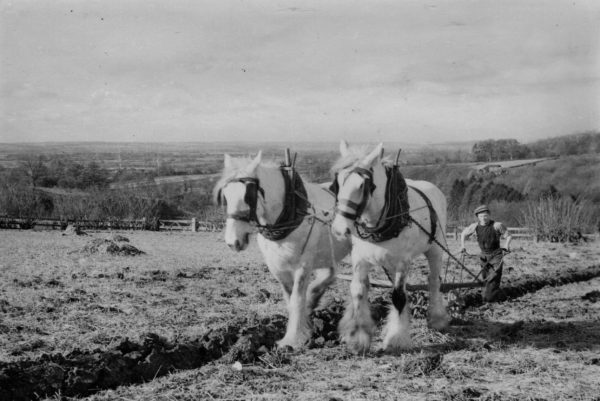
Ploughing with Shires by Raymond Hayes
Notes for Editors
Information about the Dialect and Heritage Project
The Dialect & Heritage Project is led by the School of English at the University of Leeds and funded by the National Lottery Heritage Fund, the University of Leeds’ Footsteps Fund and other alumni donations. It aims to engage new audiences with collections at the University of Leeds and at five partner museums across England. The partner museums are: Dales Countryside Museum, Ryedale Folk Museum, Weald and Downland Living Museum, Avoncroft Museum of Historic Buildings, and the Museum of East Anglian Life.
The project centres on the Leeds Archive of Vernacular Culture (LAVC), a unique and nationally important multi-media archive including the records of the Survey of English Dialects and the Institute of Dialect and Folk Life Studies. The collection is housed and accessible at the University of Leeds Special Collections: https://library.leeds.ac.uk/special-collections/collection/2571
The LAVC has been digitised to make it available to public audiences. The project will marry LAVC resources with the museums’ complementary and contemporaneous artefact collections, putting the LAVC back into the communities from which it was originally collected and where it truly belongs, reuniting tangible and intangible cultural heritage, and breathing new life into museum displays, local heritage, and the LAVC. Public engagement activities with a lasting legacy will enable visitors (in museums, in the community and online) to uncover their own cultural heritage and that of others, to learn more about their dialect inheritance, and to share their stories, memories and linguistic heritage for the benefit of current and future generations.
20 May 2022 - Sacred Spaces of the Region, Three Views
A dazzling new exhibition explores three different artists’ perceptions and portrayals of sacred places across North Yorkshire and beyond at Ryedale Folk Museum this season.
Bringing together new work by Anna Matyus, Ian Scott Massie and Stephen Guyon Bird, Reimagining Sacred Spaces combines their unique styles and approaches, at times atmospheric, intriguing or simply beautiful. At a moment when more people are opting to lead a secular lifestyle, the exhibition considers: what do sacred spaces mean to us today?
Museum Director, Jennifer Smith, says: “As any visitor knows, a short drive or walk in the region will throw up numerous signposts to heritage. Many of these are for places that have been connected with a particular religion or place of pilgrimage, at various times in history – from abbeys and priories to stone crosses. We were fascinated with the significance they still hold for people. There’s clearly something very special, albeit often intangible, about these spaces.”
The Museum invited Anna, Ian and Stephen to look at their own practices to consider what it is that they are drawn to and what it is about these places that elicits such a strong connection.
“At a time when many of us claim to have no religion, we may simultaneously acknowledge feeling something different in these traditionally religious sites – but what is it?” asks Jennifer. “Is it the weight of history, the voices of the past? Or is it something else? Is it a spiritual connection? And of course, a very great number of visitors make their excursions to marvel at the architecture to be encountered – as well as the engineering and craftsmanship that went into these great buildings.”
The exhibition features a range of well-known landmarks including Byland Abbey, Fountains Abbey, Gisborough Priory, Mount Grace Priory, Rievaulx Abbey, St Gregory’s Minster and Whitby Abbey. The exhibition doesn’t promise definitive answers, but visitors are invited to explore for themselves and to reflect on what these special places mean today.
Visitors can see Reimagining Sacred Spaces for free in the Art Gallery at Ryedale Folk Museum, from Saturday 28 May until Sunday 10 July, 10am – 5pm daily except Fridays.
Find out more about the three artists’ different approaches:
Anna Matyus
Taking inspiration from the patterns and textures of the natural world, Anna’s works explore the architecture of historic sites, often focusing on the smaller, intricate details that captivate her.
Anna says:
“The sacred spaces I capture are not wholly of human creation – there is a tranquility to be found in the solitude of the natural settings surrounding the buildings and ruins, a sense of awe and mystery that seems to have seeped into the stones which nestle there. As St Aelred wrote about Rievaulx Abbey: ‘Everywhere peace, everywhere serenity, and a marvellous freedom from the tumult of the world.’ At this moment, I think we all need some of that peace and time for reflection.”
Ian Scott Massie
Ian’s evocative watercolours render the unique character and personality of places, exploring the special sites that draw people to them and rooted within Ian’s own life in the North of England.
Ian says:
“I’m drawn to sacred spaces because of the way they feel. Standing in the cloister or the restored monk’s cell at Mount Grace Priory doesn’t just give me a sense of their history – I can feel the peacefulness and other-worldliness of the place which they must have felt.
“Putting those feelings into paint doesn’t always work but just occasionally I feel I’ve nearly cracked it and that draws me to explore and portray further special places.”
Stephen Guyon Bird
As well as expressing a preoccupation with the mechanics of drawing, Stephen approaches the theme through visual storytelling, often including figures within the landscape which hint at narratives beyond the page.
Stephen says:
“These ancient buildings embody powerful stories and for me they present a compelling challenge to look beyond their physical appearance to capture their essence, inviting the viewer to create their own stories.
“The structures crumble away due to the vicissitudes of time, weather, history, iconoclasm, war, vandalism or simply indifference and neglect. I’m constantly reminded of how fragile life is, yet the building also represents something of the eternal and the possibility of the existence of a sacred dimension in our lives.”
Open Saturday to Thursday, 10am – 5pm. Closed on Fridays.
For press enquiries, please contact Rosie Barrett: 01751 417367 or [email protected]
1 April 2022 - New exhibition reflects on the special places of the region
Saturday 2 April until Sunday 22 May
Inspired by the rural landscapes of North Yorkshire, printmaker Andrew Dalton presents a series of bold new prints in Abstract Reflections at Ryedale Folk Museum.
Many of the featured artworks are rooted in the topography of the North York Moors, although he offers a different version from the one familiar to most visitors.
Working out of his studio in Thirsk, Andrew turned to his immediate surroundings for inspiration for the exhibition. “I found myself reflecting on the landscape of the North York Moors National Park and surrounding area,” he says, “including the land directly beneath my feet – often gathering found objects on my walks which feature in my prints. The works thereby became a record of a particular moment in time and are part of a personal narrative – a distillation of moments that represent experience.”
Often rendered in black and white, his works draw on familiar landscapes of the region, though Andrew seeks to go beyond what is physically present. He explains: “Colour changes things. Adding a wash can create a beautiful haze or mist. But I don’t want to wash away the darker aspects or the reality. Black and white allow nothing to hide.
“For me, the landscape of the North York Moors is a highly-dramatic one, shaped by centuries of work. It’s easy to slip into nostalgia when exploring a place that is clearly very beautiful. But I am interested in pursuing a clarity of vision.”
Jennifer Smith, Director of Ryedale Folk Museum, says: “We’re delighted to be hosting Abstract Reflections in the Museum’s Art Gallery this season. Rather than offering a literal, photographic-style depiction, Andrew’s works explore his own reflections on the landscapes of the area, infused with his unique vision of a place, and allow the viewers to form their own responses.”
Many of the prints featured in the exhibition also explore the artist’s individual interactions with landscape, printmaking and water. “Abstract Reflections is an evocative and atmospheric journey across a range of landscapes, capturing the emotional resonance of these special places,” says Jennifer.
Abstract Reflections can be viewed in the Art Gallery at Ryedale Folk Museum, in Hutton-le-Hole in the heart of the North York Moors National Park, from Saturday 2 April until Sunday 22 May.
Entry to the Art Gallery is FREE. Open Saturday to Thursday, 10am – 5pm. (Closed on Fridays.)
For press enquiries, please email [email protected] or phone the Museum – 01751 417367
17 September 2021 - Artists open up about the experience of lockdown
An open exhibition to explore the northern landscape within the context of the pandemic launches at Ryedale Folk Museum on Saturday 18 September, as well as online via the Museum’s website.
Funded by Arts Council England, ‘In the Open’ brings together artwork in a range of media from professional, amateur and hobbying artists who have turned to the landscape for inspiration.
Jennifer Smith, Director of Ryedale Folk Museum, says: “We are absolutely delighted by the quality and variety of entries. We received over two hundred entries after what has been such a challenging year for many of us. It is encouraging to witness the broad range of people turning to art to express their feelings about landscape and countryside during the pandemic. It has been my great pleasure to bring these individual perspectives together.”
Staff at the Museum also invited entrants to submit an accompanying piece of writing, reflecting on the effects of the events of the previous eighteen months on their creative practice.
“Many artists have taken the opportunity to discuss the role that their art has played in their lives during this time, supporting them through the lockdowns in a range of really significant ways,” explains Jennifer.
Called ‘In the Open’, as well as showcasing art produced during lockdown, a central aim of the exhibition was to provide a platform for artists to speak openly and share their experiences.
“During the selection process, we had a strong sense of the therapeutic aspects of making art, as well as the benefits of spending time out of doors. It’s very moving to learn how much both their artwork and the countryside have meant to artists in these times,” says Jennifer. “Some artists have contributed very personal reflections. Taken together, they are poignant, touching and capture a particular moment in time.”
The exhibition can be viewed in the Art Gallery at Ryedale Folk Museum and online until Sunday 14 November, 2021. Open 10am – 5pm during September and 10am – 4pm in October and November. Visit the gallery page for more information.
For press enquiries, please email [email protected] or phone the Museum – 01751 417367
14 July 2021 - The artist and the land – Kane Cunningham’s ‘Northern Eutierria’
A series of dramatic new artworks by artist Kane Cunningham is showing at Ryedale Folk Museum this summer. Funded by Arts Council England, ‘Northern Eutierria’ brings together a selection of watercolours and oil paintings exploring the interconnectedness of the artist and the northern landscape during a year like no other.
On display from Saturday 24 July to Sunday 5 September, the exhibition marks a new phase in Cunningham’s work, created in response to the conditions of lockdown.
“Cunningham has a strong awareness of the complex relationship between the landscape artist and the land, including the North York Moors that surround the Museum,” says Ryedale Folk Museum’s Director, Jennifer Smith. “What we are seeing now is that this has been augmented by the conditions of lockdown. We’re delighted to host this new work, showing a change in Cunningham’s working practices, the scale of work, even his materials.”
“I have always felt uncomfortable painting without permission in the landscape,” says Cunningham, “but this feeling became more extreme during lockdown, when we were told to Stay Home. For 20 years, I have travelled from Scarborough to St. Bees, coast to coast, but in early 2020 this journey had to become imaginary.”
Though raised in Manchester, Cunningham is a long-standing resident of Scarborough and his art often responds to the landscape surrounding this coastal town – including the North York Moors to the west. The Lake District and other northern landscapes will also feature in the exhibition.
Once restrictions eased in the region, Cunningham resumed his normal painting methods, with much of his work taking place out of doors, following in the tradition of other landscape painters, including J M W Turner, whom Cunningham cites as an influence.
Like Turner, Kane often works in watercolour: “It’s my preferred medium, because it is wonderfully expressive. It allows artists to work intuitively, outside in the landscape.”
After lockdown, however, Cunningham found that he felt differently about his former working practices: “Even though I was now allowed to be outdoors, painting outside, I felt conspicuous in the landscape. I found myself wanting to be less visible, tucked away, sometimes even working from my van.
“For me, the landscape has often felt like a contested space,” explains Cunningham. “The freedom to roam in the landscape and the battle over access to the moors is well documented. Walkers’ rights to travel through common land and open countryside were protected by the CROW Act in 2000. But lockdown added another layer of complexity to this.”
Another side effect of lockdown has been a reconsideration of Cunningham’s use of materials. “With shop closures, it became impossible to browse art materials in specialist shops. I started experimenting with the natural resources surrounding me in the moors.”
Having been unable for many months to paint in front of the landscape, Cunningham now found himself painting directly from it, literally using what he found. “I began experimenting with textures and colour,” he explains, “mixing materials from the land, such as peat, water and even sheep droppings, directly with gum Arabic.
“Working at Bank Top, not far from the Hollins Mine near Rosedale, I found deposits – limonite, the residue from iron ore mining. There’s a stream which is bright orange. It’s very inspiring to paint with.” What results is a new body of work in which Cunningham has developed his relationship with the land a stage further.
‘Northern Eutierria’ is on display in the Art Gallery at Ryedale Folk Museum, in Hutton-le-Hole in the heart of the North York Moors National Park, from Saturday 24 July to Sunday 5 September.
For more information visit www.ryedalefolkmuseum.co.uk/art-gallery/
2 July 2021 - Statement from Ryedale Folk Museum about the loan of the Harrison Collection
The trustees of Ryedale Folk Museum (“the Museum”) have decided not to try to extend the loan of the Harrison Collection, which had always been for a fixed-term ending on 31 July 2022.
The Harrison Collection includes objects spanning five centuries of British social history, from cooking pots to brain surgery tools. It has been on loan to the Museum since 2012 and the much of the Harrison Collection has been on permanent public display since that time.
The Museum trustees have decided that after a decade of housing and storing the Harrison Collection, a renewal of the loan will not be sought. Therefore, the items will be returned to the care of the Harrison Collection Trust and Edward and Richard Harrison.
The trustees assessed the future of the Harrison Collection against a range of factors. This included the Museum’s Collection Development Policy, which is a policy requirement of all accredited museums. This policy sets out the themes and priorities for future collecting and rationalisation. The trustees concluded that the Harrison Collection does not fit with the criteria (including objects on loan), as the majority of the collection does not relate to the local area. The trustees also considered the impact on Museum storage, resources, care and conservation requirements and what the future aims of the Museum are.
Philip Holt, the Chair of Ryedale Folk Museum said “After a decade of displaying the Harrison Collection, we have decided that the loan should end as planned and the collection to be returned to the trustees of the Harrison Collection and Edward and Richard Harrison. We are privileged to have had the Harrison Collection, but the trustees feel that it is time to focus on the Museum’s own collection and move forward with new projects.
“The last 18 months have been particularly challenging due to the public health crisis and while I feel very optimistic about the future, the first priority is to secure the Museum’s future. This is coupled with ambitions laid out in a new ten-year strategy, which puts a greater emphasis on working with communities and local people. My fellow trustees and I believe that the decision to return the loan of the Harrison Collection will help the Museum to open-up new opportunities for growth and deliver greater public benefit.
“I would like to thank the trustees of the Harrison Collection and Edward and Richard Harrison for the kind loan of their items, and we wish them every success with their own plans for the future.”
Ryedale Folk Museum and the trustees of the Harrison Collection are now in discussion about the final year of the loan and the practical arrangements that will follow.
22 June 2021 - Final call for ‘In the Open’ – an open exhibition in response to the Northern Landscape.
There is one week remaining for professional, amateur and hobbying artists to enter their artwork for ‘In the Open’, an open exhibition to be held at Ryedale Folk Museum this autumn.
The museum has been encouraging entries that explore the Northern Landscape within the context of the pandemic, for an exhibition to launch on Saturday 18 September.
Jennifer Smith, Director of Ryedale Folk Museum, says: “We are encouraging a broad range of people to express their feelings about landscape and the countryside, providing a platform for them to share their work and reflections. Artists have until 30 June to enter.
“The increasing recognition of the value of the outdoors and nature has been widely reported during the pandemic. This has been captured in some of the responses so far. We really want to encourage anyone who has been considering submitting an entry to do so this week, about a range of experiences.”
The exhibition is funded by Arts Council England and supported by a number of artists who have shared their own experiences of working creatively during the pandemic via a series of videos, including landscape artist Kane Cunningham, photographer Joe Cornish, and sculptor Andy Goldsworthy. The selection panel will also include ceramic artist Layla Khoo.
Artists can submit an application, including a digital image of their original artwork along with between 50 and 300 words explaining their own experience of how the pandemic has influenced their art or creative practice.
The final exhibition will take place in the gallery at the Ryedale Folk Museum, in Hutton-le-Hole in the heart of the North York Moors National Park, from Saturday 18 September until Sunday 14 November.
Full details of how to enter are available via the website: Art Gallery – Ryedale Folk Museum
Photo credit: by Tessa Bunney – showing Joe Cornish at work
Media Contact – Jennifer Smith: 01751 417367
16 May 2021 - Ryedale Folk Museum launches weddings with a difference across a range of heritage buildings.
The Museum is now able to welcome couples for small and intimate weddings within nine of the twenty heritage buildings across the Museum’s six and a half acres. These include a stunning thatched Manor House, a nostalgic 1950’s village store, and even an Iron Age roundhouse.
“We think the Museum is such a romantic setting,” says Museum Director, Jennifer Smith, “with characterful historic buildings and surrounded by serene countryside – it’s ideal for a small, informal wedding built around a couple’s unique tastes.”
Weddings and civil partnership ceremonies are currently permitted in England for up to 30 people.
“We know it has been a really tough twelve months to have a wedding,” says Jennifer. “What’s heartening, though, is that Covid seems to have focused people’s thoughts on the things that really matter to them.”
Whilst the limit on wedding-guest numbers is set to be removed later in June, some couples continue to explore smaller wedding options that demonstrate their own tastes and preferences.
“Many couples really love the intimacy of a small wedding,” continues Jennifer. “They can gather with a select few of their nearest and dearest and focus on making the day really special and personal. Hosting weddings is something we’d been exploring, but a grant from the Culture Recovery Fund has enabled us to get the venture off the ground this year.”
In its idyllic, moorland location in Hutton-le-Hole, Ryedale Folk Museum is now in a unique position to cater for those seeking a quirky and intimate wedding.
“Our smallest space on offer is an Undertaker’s which can accommodate just two witnesses,” says Jennifer. “It’s not everyone’s cup of tea, of course, and not for the fainthearted, but undeniably different!”
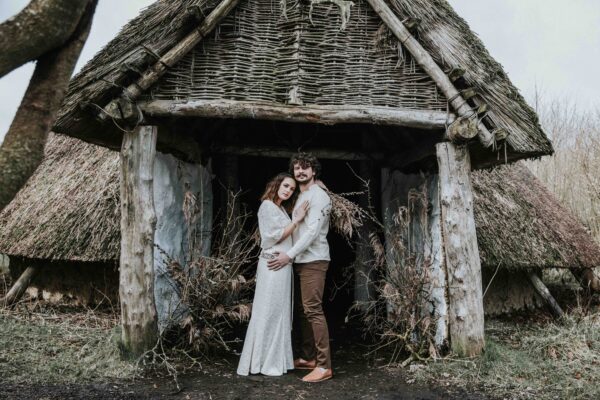
The Iron Age roundhouse, photo by Angela Waites.
8 May 2021 - Ryedale Folk Museum all set for the new season
Ryedale Folk Museum is delighted to reopen its doors to visitors, following the government confirmation that Museums can resume service this month. With a series of additional safety measures in place, the Museum is getting set to welcome visitors this season from 17 May.
“It’s really great news,” says Museum Director, Jennifer Smith. “We have missed our visitors during lockdown and know that lots of people are now ready to get out and enjoy history and culture once more.”
Across the open-air museum in Hutton-le-Hole, visitors will once again be able to explore the cottage gardens, orchard and historic farming area, traditional cornfield and 20 heritage buildings which tell the story of life across the North York Moors from the Iron Age to the 1950s. In the last few weeks, staff have been busy preparing the site for a safe reopening.
“We have a range of measures in place again this year so that staff and visitors can feel confident about returning,” says Jennifer, “as it’s really important to us that people feel able to enjoy themselves in our beautiful museum once more.
“Our absolute priority remains the safety of visitors and staff,” says Jennifer. “We received some really encouraging feedback last season about the systems we’d put in place. For smaller buildings, visitors can check that the space is empty before venturing inside due to a simple flip sign system that is operated by a foot, walking stick or umbrella.”
With over six acres, there is also plenty of outdoor space for visitors to enjoy. “As always, visitors are welcome to bring their own picnics with them,” says Jennifer, “to be eaten anywhere outside. The Museum is set in such a lovely location, with plenty of room for people to spread around, relax with a picnic, visit the animals and enjoy the sunshine.”
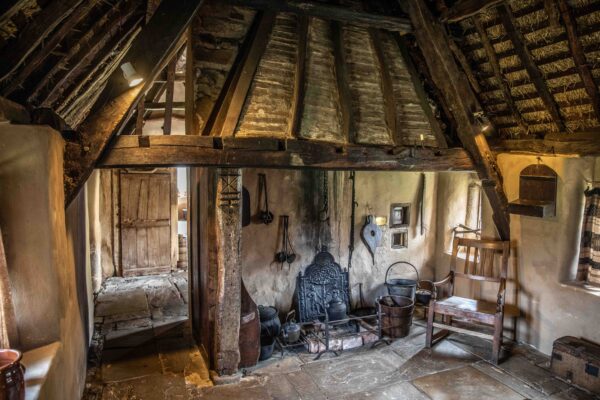
Stang End, photo by Angela Waites.
3 May 2021 - Leading artists to share the impact of the pandemic
A group of leading artists, including Andy Goldsworthy, is collaborating with Ryedale Folk Museum to explore the impact of the previous 12 months on artists and their creative practice. It will culminate in an open exhibition in September, bringing together professionals, amateurs and hobbying artists in response to the northern landscape.
The project, funded by Arts Council England, grew out of a strong awareness of the lack of access to the natural environment in adherence to the Government’s Stay Home message at the height of the pandemic. Like everyone else, artists found their travel restricted during a series of lockdowns.
Land artist Andy Goldsworthy’s latest project on the North York Moors developed from conditions created by the pandemic. ‘Southfield House’ is part of Goldsworthy’s quest to explore the environment through natural materials. “It was conceived during lockdown and made between lockdowns,” says Goldsworthy. “I wanted to make something during that period that has that sense of being uplifting. The work is now connected to that moment in time.”
Goldsworthy is one of six artists to feature in a series of videos, created by landscape painter Kane Cunningham, and also including photographer Joe Cornish, landscape painter Peter Hicks, photographer Tessa Bunney, sculptor Peter Coates and painter Francesca Simon. The videos will be shared throughout May and June.
“At its heart, the project is an opportunity for artists to share their experiences and to encourage others who may have seen significant changes to their output because of Covid-19,” explains Ryedale Folk Museum’s Director, Jennifer Smith.
“Through Kane Cunningham’s films, we are seeing honest and open discussions about the challenges – and, sometimes, the opportunities – faced by the artistic community.
“Situated within the North York Moors National Park, we needed only to look outside the museum window to realise that there was nobody here during lockdown. One question that interested us was what impact that was having on artists who respond directly to the landscape and who make their living from that inspiration,” says Smith.
The partnership with Kane Cunningham was a natural one. “For 20 years, I’ve travelled from Scarborough to St. Bees, coast to coast,” explains Cunningham. “In a normal year, my art takes me over hill and dale and across mountain pathways to find the perfect view.”
The sense of loss during lockdown led to a desire to reach out to others on this theme: “I felt the need to discover more about the landscape and what it means to me and other artists in these challenging times. Has it changed the way they think about their work? Has it changed the way they think about the landscape?”
The Museum hopes that sharing the contemplations of other artists will inspire people to create new work or reflect on a piece created since the start of the pandemic, to feature in the open exhibition of two- and three-dimensional work from September.
The submission window opens this week until 30 June, with the selection panel to include Cunningham, Joe Cornish and ceramic artist Layla Khoo.
Artists and other creative practitioners, of any art form, are also invited to send their own brief film clips (less than a minute long) to be shared on social media, responding to the question: ‘How has your creative practice changed in the last 12 months?’
21 April 2021 - New exhibition at Ryedale Folk Museum depicts the ‘incomparable beauty’ of The North
An exhibition of paintings and prints depicting the ‘incomparable beauty’ of The North opens in the art gallery at Ryedale Folk Museum in May.
Ian Scott Massie’s Northern Soul represent the artist’s personal journey of 45 years living in The North. It can be seen from Monday 17 May to Sunday 11 July at the Museum at Hutton-le-Hole, in the heart of the North York Moors National Park.
The 50 watercolours and screenprints portray northern views as diverse as Bamburgh and Barnsley, and landmarks ranging from Fountains Abbey to the Tees Transporter Bridge. The images reach right across the country from Newcastle to Liverpool.
Raised in Buckinghamshire, Massie moved north in the 1970s to study at Durham University. He now lives in Masham in the Yorkshire Dales with his artist wife, Josie Beszant.
He began working in watercolours ‘to paint quickly’ when his children were small, and cites JMW Turner as an influence.
“The depth of colour, the freedom of the expression and the speed at which a picture could come together captivated me,” he says.
The North, he says is ‘the truth of England, where all things are seen clearly: the incomparable beauty of the landscape, the harsh ugliness left by industry, the great wealth of the aristocracy, the miserable housing of the poor, the civic pride of the mill towns and a people as likely to be mobilised by political oratory as by a comedian with a ukulele’.
“Both the pictures for Northern Soul and the book take a very long view of The North, reaching back into my personal history and the history of the region. The exhibition also refers to my time working as a music researcher for Beamish Museum (which I loved), from which experience grew an interest in the industrial, social and folk culture of The North which Ryedale Folk Museum reflects so beautifully.”
Jennifer Smith, Director of Ryedale Folk Museum, says: “I am delighted that we will open Ian’s exhibition on the same day as Ryedale Folk Museum, following a six-month period of closure. Northern Soul is a stunning and atmospheric journey across northern England. Ian captures the beauty, wildness and culture of The North, transporting the viewer to the places featured in his magical paintings and prints.
“The fact that we can share these works online, as well as in the art gallery, means that even if people can’t or don’t want to travel, they can feel nostalgic about their favourite northern places and maybe discover some new ones too.”
Northern Soul can be seen at the art gallery at Ryedale Folk Museum from Monday 17 May to Sunday 11 July 2021. The gallery is open daily from 10am to 5pm. Entry to the gallery is free.
The exhibition will also be available to view on the Ryedale Folk Museum website during the same period: www.ryedalefolkmuseum.co.uk/art-gallery/
A book accompanying the exhibition will be available to buy from the museum’s shop and online via the website at a cost of £26 (plus P&P if bought from the website).
